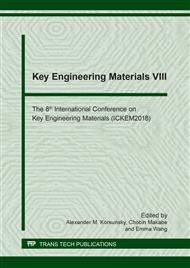[1]
D. Drysdale, A. Macmillan, Flame spread on inclined surfaces, Fire Saf. J. 18 (1992) 245-254.
DOI: 10.1016/0379-7112(92)90018-8
Google Scholar
[2]
J. Zhang, T. Shields, G. Silcock, Effect of melting behaviour on upward flame spread of thermoplastics, Fire Mater. 21 (1997) 1-6.
DOI: 10.1002/(sici)1099-1018(199701)21:1<1::aid-fam583>3.0.co;2-p
Google Scholar
[3]
J.G. Quintiere, The effects of angular orientation on flame spread over thin materials, Fire Saf. J. 36 (2001) 291-312.
DOI: 10.1016/s0379-7112(00)00051-5
Google Scholar
[4]
A.S. Rangwala, S.G. Buckley, J.L. Torero, Upward flame spread on a vertically oriented fuel surface: The effect of finite width, Proc. Combust. Inst. 31 (2007) 2607-2615.
DOI: 10.1016/j.proci.2006.07.235
Google Scholar
[5]
Y. Pizzo, J.L. Consalvi, B. Porterie, A transient pyrolysis model based on the B-number for gravity-assisted flame spread over thick PMMA slabs, Combust. Flame 156 (2009) 1856-1859.
DOI: 10.1016/j.combustflame.2009.06.007
Google Scholar
[6]
M.J. Gollner, X. Huang, J. Cobian, A.S. Rangwala, F.A. Williams, Experimental study of upward flame spread of an inclined fuel surface, Proc. Combust. Inst. 34 (2013) 2531-2538.
DOI: 10.1016/j.proci.2012.06.063
Google Scholar
[7]
X. Huang, M.J. Gollner, Correlations for Evaluation of Flame Spread over an Inclined Fuel Surface, Fire Saf. Sci. 11 (2014) 222-233.
DOI: 10.3801/iafss.fss.11-222
Google Scholar
[8]
F. Peng, L.Z. Yang, X.D. Zhou. Experimental Study on Effect of Ceiling on Upward Flame Spread over Poly (Methyl Methacrylate) Sheets. In: editor^editors. Key Eng. Mater. 2016: Trans Tech Publ. pp.114-118.
DOI: 10.4028/www.scientific.net/kem.705.114
Google Scholar
[9]
M.J. Gollner, C.H. Miller, W. Tang, A.V. Singh, The effect of flow and geometry on concurrent flame spread, Fire Saf. J. 91 (2017) 68-78.
DOI: 10.1016/j.firesaf.2017.05.007
Google Scholar
[10]
Y. Wu, H. Xing, G. Atkinson, Interaction of fire plume with inclined surface, Fire Saf. J. 35 (2000) 391-403.
DOI: 10.1016/s0379-7112(00)00032-1
Google Scholar
[11]
Q. Xie, H. Zhang, R. Ye, Experimental study on melting and flowing behavior of thermoplastics combustion based on a new setup with a T-shape trough, J. Hazard. Mater. 166 (2009) 1321-1325.
DOI: 10.1016/j.jhazmat.2008.12.057
Google Scholar
[12]
Y. Wang, J. Zhang, Thermal stabilities of drops of burning thermoplastics under the UL 94 vertical test conditions, J. Hazard. Mater. 246 (2013) 103-109.
DOI: 10.1016/j.jhazmat.2012.12.020
Google Scholar
[13]
D. Smith, Measurements of flame length and flame angle in an inclined trench, Fire Saf. J. 18 (1992) 231-244.
DOI: 10.1016/0379-7112(92)90017-7
Google Scholar
[14]
P. Woodburn, D. Drysdale, Fires in inclined trenches: the dependence of the critical angle on the trench and burner geometry, Fire Saf. J. 31 (1998) 143-164.
DOI: 10.1016/s0379-7112(98)00004-6
Google Scholar


